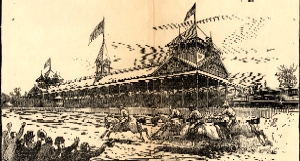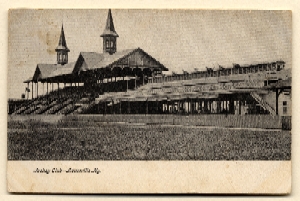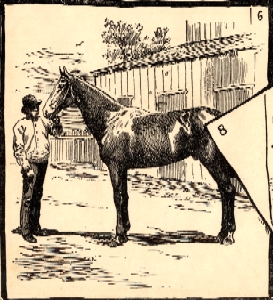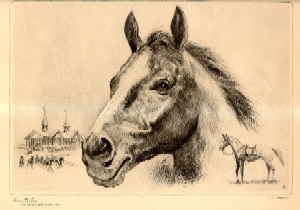From The Filson Collections: The Kentucky Derby
The hum of excitement that permeates Louisville in the days leading up to the Kentucky Derby has been a fixture from the beginning, as documented in these items from The Filson’s collections.
By Elizabeth Kissack
Special Collections Assistant
About |
 Some 130 years later this prediction remains accurate, but there are more parallels between the festivities
of the 19th century and today than one might expect. For instance, the emphasis on women’s Derby fashion is not a new trend. Before the first Derby
in 1875, an ad in the Louisville Saturday Review announced, “Fashionable ladies who attend the races next week will wear imported English silk
riding hats.”
Some 130 years later this prediction remains accurate, but there are more parallels between the festivities
of the 19th century and today than one might expect. For instance, the emphasis on women’s Derby fashion is not a new trend. Before the first Derby
in 1875, an ad in the Louisville Saturday Review announced, “Fashionable ladies who attend the races next week will wear imported English silk
riding hats.”
The hum of excitement that permeates the city in the days
leading up to the Derby has also
been a fixture from the beginning.  On the first Derby Day, a Courier-Journal article stated, “the races were the all-absorbing topics of conversation,
speculation and discussion… through all the city.” And the pomp, as well as the throngs of spectators, are not new;
in a letter from the Filson’s Special Collections, a young woman named Daisy writes that the 1882 Derby was a “grand, large, elegant” affair, with
“of course an extra crowd.”
On the first Derby Day, a Courier-Journal article stated, “the races were the all-absorbing topics of conversation,
speculation and discussion… through all the city.” And the pomp, as well as the throngs of spectators, are not new;
in a letter from the Filson’s Special Collections, a young woman named Daisy writes that the 1882 Derby was a “grand, large, elegant” affair, with
“of course an extra crowd.”
If a 19th-century Louisville newspaper article mentioned women in relation to the Derby, it was typically to comment on their colorful attire.
However, in 1890 the Critic, a Louisville society newspaper, stated that
“the ladies… are taking more interest in the  races this year than ever before.” But
according to the Critic, women should not show too much interest, for the newspaper
also complained bitterly
of "the habit certain young women have of following the races and laying wagers upon the horse that strikes their fancy." Such behavior was
"not very decent."
races this year than ever before.” But
according to the Critic, women should not show too much interest, for the newspaper
also complained bitterly
of "the habit certain young women have of following the races and laying wagers upon the horse that strikes their fancy." Such behavior was
"not very decent."
Just as the first Derby brought excitement to Louisville in 1875, the Kentucky Derby today remains an event bursting with civic pride.
For one Saturday in May, the nation's attention turns to Churchill Downs and to Louisville as the city showcases its culture, its fashion sense, and
most importantly, its tradition.
The Filson Historical Society
1310 South Third Street - Louisville, KY 40208
Phone: (502) 635-5083 Fax: (502) 635-5086
Hours
The Ferguson Mansion and Office
Monday - Friday: 9 am. - 5 pm.
Saturday and Sunday closed
Library
Monday - Friday: 9 am. - 5 pm.
Saturday: 9 am. - 12 noon
